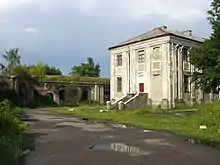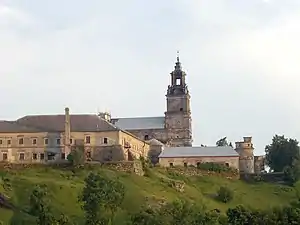Brody Raion
Brody Raion (Ukrainian: Бродівський район, romanized: Brodivs’kyi raion) was a raion (district) of Lviv Oblast in western Ukraine. Its administrative center was Brody. The raion was abolished on 18 July 2020 as part of the administrative reform of Ukraine, which reduced the number of raions of Lviv Oblast to seven. The area of Brody Raion was merged into Zolochiv Raion.[1][2] The last estimate of the population of the raion was 57,457 (2020 est.).[3]
Brodivskyi Raion
Бродівський район | |
|---|---|
 Flag  Coat of arms | |
 | |
| Coordinates: 50°2′30″N 25°6′47″E | |
| Country | |
| Region | |
| Disestablished | 18 July 2020 |
| Admin. center | Brody |
| Subdivisions | List
|
| Population (2020) | |
| • Total | 57,457 |
| Time zone | UTC+02:00 (EET) |
| • Summer (DST) | UTC+03:00 (EEST) |
| Area code | 380-3266 |
| Website | http://www.brody.lviv.ua Brody |
The raion was located at the easternmost portion of Lviv Oblast bordering with Rivne and Ternopil Oblasts to its east, Volyn Oblast to the north, Radekhiv Raion to the northwest, Busk Raion to the west, and Zolochiv Raion to the southwest.
Historically, the district (county) became known as border checkpoint between the Austria-Hungary Empire and the Russian Empire. As a county (powiat) it was established in 1866 as part of the Kingdom of Galicia and Lodomeria. After World War I, the area became part of the Second Polish Republic within the Tarnopol Voivodeship. During the invasion of Soviet forces at the beginning of World War II, the district was established by the Soviet administration.
The raion had a city administrative area, a "town with three other villages" administrative area and 23 rural councils which were formed out of the rest of the 73 villages. Some councils included up to 10 villages (Ponykva), while some consisted only of a pair of villages.
Subdivisions
At the time of disestablishment, the raion consisted of three hromadas:[4]
- Brody urban hromada with the administration in Brody;
- Pidkamin settlement hromada with the administration in the urban-type settlement of Pidkamin;
- Zabolottsi rural hromada with the administration in the selo of Zabolottsi.
Landmarks of architecture

- Ruins of the Brody Castle, built by Guillaume Le Vasseur de Beauplan (1630–1635)
- Church of Vozdvyzhenia Chesnoho Khresta (former kosciol, 1660)
- Church of the Nativity of the Virgin Mary (18th century)
- Church of Saint George (18th century)
- Church of Holy Trinity (1750s)
- Ruins of Brody Synagogue (1750s)
- Jewish Cemetery in Brody

- Pidhirtsi Castle, built by Beauplan
- Castle's kosciol
- Inner court with a solar clock
- Castle's garden
- Church of Saint Michael (18th century)
- 400-year-old linden tree
- Plisnysko Gord
- Order of Saint Basil Monastery (18th century)

- Monastery UGCC (earlier Dominican Order) (Pidkamin)
- Building of kosciol
- Monastery cells
- Defensive walls and bastions
- Corinth column with a statue of the Virgin Mary
- Several towns chapels
- Dominican cemetery
- 17-meter tall rock, leftover of a sea reef
- Wooden kosciol of Yazlivchyk (1930s)
- Potocki Palace in Konyushkiv (18th century)
- Cossack cemetery near Shnyriv (1651)
- Kosciol ruins of the former Order of Saint Bernardine Monastery
Education
- Markian Shashkevych Brody Pedagogical College
Health care
- Brody Central District Hospital
- Pidkamin City Hospital
- Zabolotsi District Hospital
- Dental Clinic
References
- "Про утворення та ліквідацію районів. Постанова Верховної Ради України № 807-ІХ". Голос України (in Ukrainian). 2020-07-18. Retrieved 2020-10-03.
- "Нові райони: карти + склад" (in Ukrainian). Міністерство розвитку громад та територій України.
- Чисельність наявного населення України на 1 січня 2020 року / Population of Ukraine Number of Existing as of January 1, 2020 (PDF) (in Ukrainian and English). Kyiv: State Statistics Service of Ukraine.
- "Бродівська районна рада (состав до 2020 г.)" (in Russian). Портал об'єднаних громад України.